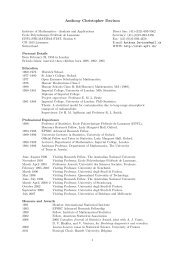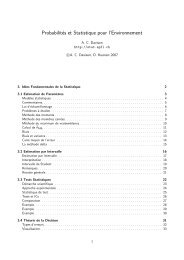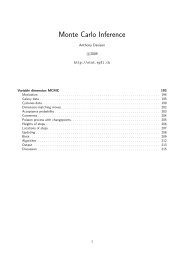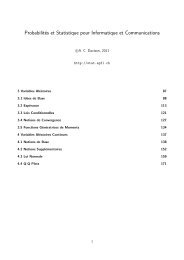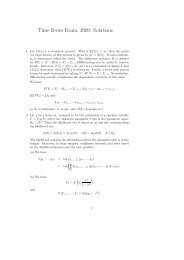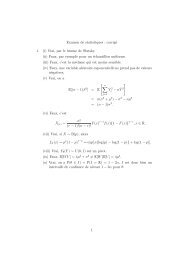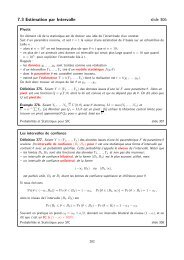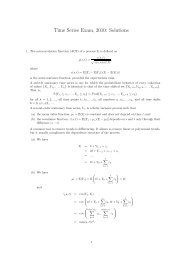Probabilités et Statistique pour SIC: Correction des exercices 2012
Probabilités et Statistique pour SIC: Correction des exercices 2012
Probabilités et Statistique pour SIC: Correction des exercices 2012
You also want an ePaper? Increase the reach of your titles
YUMPU automatically turns print PDFs into web optimized ePapers that Google loves.
Corrigé 88 a) On a E(¯T) = θ/2 <strong>et</strong> Var(¯T) = θ212n donc E(θ 1) = θ <strong>et</strong> Var(θ 1 ) = θ23n → 0.b) P(M n < m) = P(T 1 < m <strong>et</strong> T 2 < m... <strong>et</strong> T n < m), donc⎧⎨ (m/θ) n si m ∈ [0,θ]P(M n < m) = 1 si m > θ⎩0 si m ≤ 0Par intégration, E(M n ) = nθn+1 <strong>et</strong> E(M2 n ) = nθ2n+2 donc Var(M n) =nθ 2(n+2)(n+1) 2 .c) On prend θ 2 = n+1n M n. On a E(θ 2 ) = θ <strong>et</strong> Var(θ 2 ) = θ2n(n+2)→ 0 quand n → ∞.d) Puisque la variance de θ 2 est plus faible que la variance de θ 1 (donc risque quadratique plus faible),il est préférable d’utiliser θ 2 .<strong>et</strong>e) M n <strong>et</strong> θ 2 convergent vers θ en probabilité car:∀ǫ > 0, P{|M n −θ| > ǫ} = P{(θ−M n ) > ǫ} = ( θ −ǫ ) n −→ 0θP{|ˆθ 2 −θ| > ǫ} = P{|M n − nn+1 θ| > nn+1 ǫ} = P{M n < nn+1 (θ−ǫ)}+P{M n > n (θ+ǫ)} −→ 0.n+1Corrigé 89 a) La loi a posteriori s’écritb) La densité a posteriori s’écritqui est maximale lorsquesoit l’estimateur du maximum a posteriorif(θ|t) ∝ f(t|θ)f(θ) ∝ θe −θ(λ+t) .f(θ|t 1 ,...,t n ) ∝ θ n e −θ(λ+∑ ni=1 ti)nθ n−1 −θ n (λ+ˆθ MAP =Corrigé 90 a) D’après l’énoncé, la loi a priori de p est)n∑t i = 0i=1nλ+ ∑ ni=1 T iP(p = 0.05) = P(p = 0.1) = 0.5.Pour p fixé, X suit une loi binomiale de paramètres n = 20 <strong>et</strong> p:b) D’après la formule <strong>des</strong> proabilités totales,P(X = k|p) = C k n pk (1−p) n−k .P(X = 3) = P(X = 3|p = 0.05)P(p = 0.05)+P(X = 3|p = 0.1)P(p = 0.1)= 0.0596×0.5+0.1901×0.5 = 0.1249.c) Parmi les 20 composants, 3 composants ont été détectés comme défecteux. Les probabilités aposteriori de p = 0.05 <strong>et</strong> p = 0.1 sont, d’après le théorème de Bayes,P(p = 0.05|X = 3) =P(p = 0.1|X = 3) =P(X = 3|p = 0.05)P(p = 0.05)P(X = 3)P(X = 3|p = 0.1)P(p = 0.1)P(X = 3)= 0.0596×0.50.1249= 0.1901×0.50.1249= 0.2386= 0.7614Il est a posteriori trois fois plus probable que 10% <strong>des</strong> composants soient défectueux, plutôt que 5%.d) L’espérance a posteriori de p estE(p|X = 3) = 0.05×P(p = 0.05|X = 3)+0.1×P(p = 0.1|X = 3) = 0.0881.22



